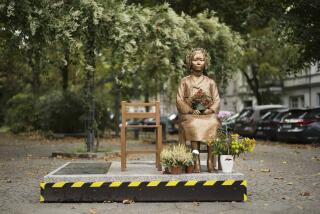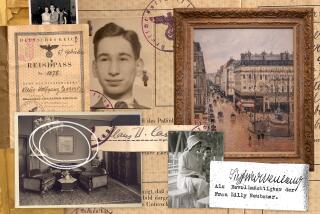EUROPE : Nazi Symbol to Return to German Hands : Hitler’s mountain retreat has been under U.S. control for 50 years. But Bonn reluctantly agreed to acquire it after renovation talks broke down.
- Share via
BERCHTESGADEN, Germany — Obersalzberg mountain, Adolf Hitler’s Alpine home away from home in southern Germany, was bombed by British forces in the final days of World War II before U.S. soldiers marched in to raise the American flag over the ruins.
Fifty years later, U.S. Army Europe is preparing to return Obersalzberg to the German government, which only reluctantly agreed to take back the spectacular resort with a Nazi past.
German officials have long believed that the U.S. presence on Obersalzberg helped to ensure that neo-Nazis did not make a shrine out of the Third Reich retreat in the area where Hitler reportedly penned part of his fascist, anti-Semitic professions in “Mein Kampf.”
The federal government was negotiating with the Americans to stay on until both sides announced last week that the deal had fallen through.
Located just above the castle town of Berchtesgaden, on the snowy Bavarian border with Austria, Obersalzberg served throughout the Cold War as one of a handful of recreation centers for hundreds of thousands of American forces stationed in Europe.
With the drawdown to 100,000 U.S. troops in Europe, the army decided to close one of its vacation spots and picked the relatively rundown winter ski and summer golf resort at Berchtesgaden. The military chose to keep another complex in Garmisch-Partenkirchen and a renovated facility at the Chiemsee.
“The German government came to us in 1993 and said they would like us to return Chiemsee and that they would renovate Berchtesgaden so we could keep that,” said Richard Gorman, general manager of the Armed Forces Recreation Centers Europe. “They wanted us to stay there, and since the government offered to pay, we were glad to accommodate.”
But as estimated costs of renovation shot up from 20 million German marks to 30 million marks--about $20 million--during a time of cutbacks and economic crisis, the German government balked. When it finally approved the funds, it demanded a guarantee that the Americans would stay 10 years after the project was completed--a commitment the Americans could not make.
“The best the U.S. government could say is that we would remain contingent on the troops staying at the same level,” said Chuck Fothergill, manager of the Berchtesgaden recreation center. “As long as there were 100,000 troops in Europe, we would stay in Berchtesgaden.”
*
That was not enough for the Germans, who, after a year of back and forth, withdrew their offer to renovate last week, thus agreeing to accept the return of Berchtesgaden.
The Bavarian prime minister’s office announced the federal finance minister’s decision, ending its press statement with assurances that the site “will not become a mecca for neo-Nazis and ultraconservatives.”
Despite its natural beauty, visitors to Obersalzberg cannot help but look at the mountain through the lens of ugly history.
Hitler discovered this area after his release from prison for the unsuccessful putsch of 1923 in which he and his allies sought to seize the government of Bavaria. He bought his house here shortly after coming to power in 1933. He eventually enlarged the house and shared it with his mistress, Eva Braun.
Hundreds of locals were evacuated from the mountain, and members of Hitler’s inner circle moved in: Nazi Party chief Martin Bormann, Marshal Hermann Goering and Armaments Minister Albert Speer built summer houses. Bormann, for Hitler’s 50th birthday, built the mountain’s crowning jewel: the Eagle’s Nest tearoom at 6,000 feet.
Bormann had the whole area fenced off to outsiders, although thousands of Nazi supporters trekked up the hill daily on the chance they might catch a glimpse of the Fuhrer on a hike or even have a word with him.
During the war, Bormann also built a network of tunnels and air raid shelters for Hitler, who, as it turned out, was in Berlin when Obersalzberg was bombed.
The German government had the remains of Hitler’s house destroyed in 1952 to prevent its becoming a shrine. But officials left the Eagle’s Nest tearoom, which is open to the public in summer.
The Americans have occupied several other area buildings, including the former Platterhof Hotel--now the Gen. Walton Walker Hotel; a Nazi Party model farm that is the Skytop Lodge; Speer’s home, and an alternate chancellery that Hitler rarely used. These, and the gorgeous grounds, are to be given to the state government of Bavaria.
More to Read
Sign up for Essential California
The most important California stories and recommendations in your inbox every morning.
You may occasionally receive promotional content from the Los Angeles Times.










